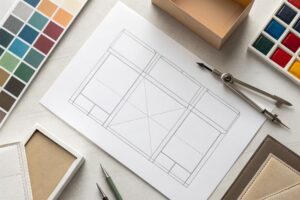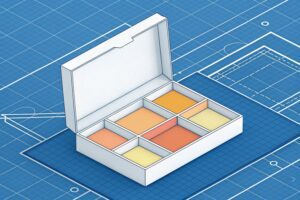I see missed sales when a display looks good but fails in the aisle. I solve that gap with clear goals, fast tests, and simple rules.
Yes. Start with one goal, size to the store, choose the right corrugate grade, keep one core message, use flat-pack engineering, control color with proofs, and run a 24-hour strength and transit test before sign-off. This fixes 80% of display failures.

I will show what works, why it works, and how you can copy it today. I will keep the steps short and clear. I will add a real case later.
How can I improve my Display?
Many displays try to do everything. Shoppers then ignore them. I focus the message, fix the structure, and clean the path to pick-up.
Improve your Display by setting one goal, using a simple hero panel, placing product at hand height, cutting copy by half, adding one QR or price tag, and testing with three shoppers for five minutes each. Keep what they touch first.

Make one promise, then back it up
I write one promise on the header. I keep it under seven words. I add one proof, like a claim, a review, or a clear use photo. I choose the structure by product weight. I place heavy items low and near the front. I put trial items high and near the right because most shoppers turn right. I center one hero SKU to avoid choice overload. I use a 3-second rule1. If a stranger cannot say what the display sells in three seconds, I cut elements until it works. I learned this while building a floor display2 for an outdoor brand. Hunters moved fast. They grabbed what they saw first. A clean header beat a busy one by 28% in pick-ups.
| Element | Action | Why it works |
|---|---|---|
| Header copy3 | ≤7 words, one promise | Fast read in motion |
| Hero image | One use scene, no collage | Reduces cognitive load |
| Product layout4 | Heavy low; trial high; center hero | Matches reach and scan paths |
| Price/CTA | One price tag or QR near right hand | Eases decision at the moment of grab |
| Shelf talkers | Use only on facing edges | Keeps sight lines clean |
How do I optimize my Display?
Deadlines are tight. Budgets are tight. I optimize by balancing strength, cost, speed, and color. I remove steps that do not change sales.
Optimize by picking the right board grade, using flat-pack parts, standardizing print specs, kitting by store, and locking a one-week learn-and-fix loop. This gives strength, lowers freight, and speeds launch.

Engineer strength, then buy back cost
I start with structure. For most floor units I spec E/B double-wall or B/C for heavy gear. I target a 3× safety factor5 on static load. I cut tool count with shared tabs and mirrored parts. I switch to flat-pack6 to cut cube and damage. I use water-based inks and a standard profile to steady color. I approve a wet proof only once, then lock it. I move from custom outer boxes to standard shipper sizes when the unit allows. I build a small pilot of 20 stores to learn. One outdoor case hit a price wall. We dropped one shelf, kept facings with a riser, and saved 12% board without losing sales. Speed improved because pack out got easier.
| Parameter | Target/Choice | Tool or Check |
|---|---|---|
| Board grade | E/B or B/C for heavy items | Compression test (3× load)7 |
| Parts count | ≤8 unique parts | Shared die cut lines |
| Pack method | Flat-pack with QR SOP8 | Kitting checklist |
| CMYK + 1 spot if needed | Wet proof once, lock profile | |
| Freight | ≤0.5 m³ per unit | Pallet Tetris plan |
How to manage Display settings?
Files get messy fast. Versions drift. Colors shift. I stop this with simple settings and a clear naming rule.
Manage settings by locking dielines, using one color profile, setting 300 dpi images, adding 2 mm bleed, naming files with version and date, and attaching assembly SOPs with photos and QR codes. This prevents rework and late color surprises.

Standard files, clear names, zero doubt
I keep one master dieline9 in PDF and AI. I name it like BRAND_SKU_DISPLAYTYPE_SIZE_V03_2025-10-28.ai. I set CMYK with GRACoL or FOGRA, not RGB. I set images at 300 dpi at 100% size. I add 2 mm bleed and 3 mm safe zone. I keep barcodes at 100% with a quiet zone. I place fold icons and numbers on the non-print layer. I attach an SOP with six photos for pack out. I print a QR code10 on the inside flap that links to a 60-second assembly video. This simple stack cut approval time in half for a hunting bow launch. The buyer saw one folder. The factory saw one truth. No one guessed.
| Setting | Spec/Rule | Reason |
|---|---|---|
| Color profile | CMYK GRACoL/FOGRA | Predictable press color |
| Image resolution11 | 300 dpi at 100% size | Sharp edges in print |
| Bleed/Safe | 2 mm bleed / 3 mm safe | Trims without white edges |
| Barcode | 100% size + quiet zone | Scan passes first time |
| File naming12 | BRAND_SKU_TYPE_SIZE_V##_YYYY-MM-DD | Version control clarity |
| Assembly SOP | Photos + QR video | Fewer store-level mistakes |
How to check Display quality?
I trust what I measure. I check board, print, strength, and transit. I write pass/fail rules. I do not ship on hope.
Check quality with AQL sampling, color swatches under D50 light, 24-hour load tests at 3× weight, and ISTA-style drop and vibration tests. Approve only when parts, print, and pack pass in the same run.

Test what matters, under real stress
I start with incoming board. I check edge crush and moisture. I spot-check flute direction on load parts. I compare print to a signed swatch under D50 light. I allow a tiny delta-E only on non-critical areas. I run a 24-hour static load at three times the planned weight. I do a push test on hooks. I run a short ISTA sequence13 for drops and vibration on the packed unit. I use AQL 2.514 for minor and 1.0 for major defects. I record results with photos and a simple scorecard. On a crossbow floor unit, this removed a weak shelf early. We added a hidden brace and turned a risky launch into a calm one.
| Test | Method/Tool | Pass/Fail Rule |
|---|---|---|
| Color match15 | Swatch under D50 | ΔE within agreed limit |
| Static load16 | 24 h at 3× weight | No sag, no tear |
| Transit | Drop + vibration (ISTA-style) | No crushed corners, parts intact |
| AQL sampling | AQL 2.5 minor / 1.0 major | Below thresholds |
| Barcode scan | Handheld scanner | 100% readable |
How to make the Display fit the screen?
Teams preview designs on screens. Stores need real sizes. I align both. I scale right and I protect edges with safe zones.
Fit the Display by measuring the store space, mapping a design grid, keeping a 3 mm safe zone, proofing at 100% on a plotter, and matching the 3D render to a real sample. Adjust once, then lock.

Size for screens, shelves, and human hands
I collect true store sizes first: height under signage, baseboard depth, and any power outlets. I build a grid in the dieline that matches those limits. I set a 3 mm safe zone17 for all text and logos. I use 1:1 plotter prints to check cut lines and fold lands. I render a quick 3D view and place it into a store photo. I check reach zones at 1.2–1.6 m for adult hands. For e-commerce photos18, I export a clean frontal view at a standard pixel width, and I keep colors within the same CMYK profile so the results match reality. I learned this on a rush job. The header touched a sprinkler line in one store. The grid saved us. We trimmed the top by 15 mm. The unit fit, and the deadline held.
| Dimension/Area | Tolerance/Rule | Action |
|---|---|---|
| Overall height | −15 mm safety margin19 | Avoid signs and sprinklers |
| Depth | Match baseboard | Prevent tip and block |
| Safe zone | 3 mm inside cut line | Protect text and logos |
| Screen preview | 100% scale mockup20 | Spot small type issues |
| 3D render ↔ sample | Photo overlay check | Align look with real build |
Conclusion
I set one goal, I pick the right board, I lock file settings, I test hard, and I fit both screen and store. This keeps launches calm.
Understanding the 3-second rule can enhance your marketing strategies, ensuring clarity and effectiveness in your displays. ↩
Explore expert tips on designing floor displays to maximize product visibility and customer engagement. ↩
Explore this link to learn how concise header copy can enhance user engagement and improve conversion rates. ↩
Discover insights on how strategic product layout can optimize customer experience and boost sales. ↩
Understanding safety factors is crucial for ensuring structural integrity and reliability in engineering designs. ↩
Exploring flat-pack design can reveal innovative solutions for space-saving and cost-effective shipping in product development. ↩
Understanding compression tests is crucial for ensuring the durability of heavy items in packaging. ↩
Exploring flat-pack methods can enhance efficiency and organization in your packaging process. ↩
Understanding master dielines is crucial for effective design and production processes, ensuring clarity and consistency. ↩
Creating a QR code can enhance customer engagement by linking to valuable content, making your packaging more interactive. ↩
Understanding image resolution is crucial for achieving high-quality prints without pixelation. ↩
Proper file naming conventions help maintain organization and clarity in design projects. ↩
Understanding ISTA sequences can enhance your knowledge of packaging testing standards and improve product reliability. ↩
Exploring AQL 2.5 will provide insights into quality control measures, helping you ensure product excellence. ↩
Understanding color matching techniques can enhance product quality and customer satisfaction. ↩
Learning about static load testing can help ensure product durability and safety. ↩
Understanding the 3 mm safe zone is crucial for ensuring that important elements are not cut off in printing. ↩
Optimizing e-commerce photos can significantly enhance product visibility and increase sales, making it essential for online retailers. ↩
Understanding safety margins is crucial for ensuring compliance and avoiding costly mistakes in design. ↩
Exploring the significance of 100% scale mockups can enhance your design accuracy and effectiveness. ↩




